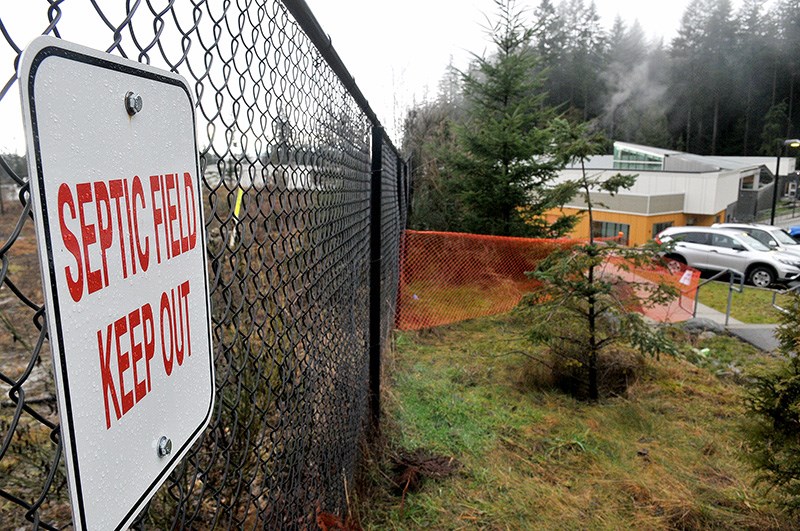The mayor of Anmore says the village has received an application to subdivide a two-acre property that is part of Anmore Green Estates into 14 lots, and that may be a reason behind the strata’s latest push to get hooked into Port Moody’s municipal sewage system.
On Dec. 23, the strata erected protective fencing and bright yellow warning signs around a hillside next to Eagle Mountain middle school (which is located in Anmore) and behind Heritage Woods secondary (located close by but in Port Moody) to comply with an order from B.C.'s Ministry of Environment after soil tests at eight locations on that property showed high levels of E. coli and fecal coliform in four samples and moderate levels in three more. Another came back with no detectable levels. The contamination is believed to have leached from Anmore Green’s septic field.
But Anmore Mayor John McEwen said he has seen no evidence that the contamination is human waste or that it is leaking from the septic field.
“At this point, it is strictly a preliminary thing that is there,” McEwen told The Tri-City News. “If a septic field fails, then it has to be determined whether it’s animal or human waste that could cause the contamination.”
McEwen said previous testing, including six months of monitoring during the construction of Eagle Mountain middle, showed no signs of spill-off from the nearby septic field.
All of Anmore is on septic systems, although an exception was made to allow Eagle Mountain to be hooked into PoMo's sewer system. McEwen said it’s part of the village’s strategy to limit its growth and residents aren’t prepared to bear the $147,000 annual cost of belonging to the Greater Vancouver Sewerage and Drainage District (GVS&DD), which spreads the cost of the region’s sewer systems — including money for new infrastructure projects — across all member municipalities.
“People are pretty adamant up here they don’t want sewers,” McEwen said, adding the village’s recently adopted official community plan states new development can’t exceed a density of 1.8 lots per acre of land.
But the president of Anmore Green’s strata called that a “paper tiger.”
Robert Boies said McEwen is using “fear mongering about development pressure” to prevent a quick and easy solution to a septic system that has been failing for years and has cost owners in Anmore Green hundreds of thousands of dollars. He said the strata continues to bear the expense of ongoing testing and regular pumping of the septic field after previous attempts to repair it failed.
“There’s been a lot of strife in the Anmore Green community about fixing it or not fixing it,” Boies said, adding strata owners are willing to pay the costs of hooking the development into Port Moody’s sewer system — which he said is estimated to be $250,000 — to be rid of the problem.
In fact, the issue of hooking the strata complex into the sewers has come up several times in the past 16 years.
Last November, PoMo Mayor Mike Clay sent a letter to the village of Anmore that said hooking Anmore Green Estates into the municipal sewer system was “the best solution” provided certain conditions were met and all costs were borne by the strata. If that wasn’t acceptable to the village, he suggested redrawing municipal boundaries to bring the complex within Moody city limits.
“We have offered up our assistance as we can,” Clay said.
In 2007, Anmore council submitted a request to Metro Vancouver to consider hooking Anmore Green into the GVS&DD sewer system but that initiative stalled when the strata balked at paying $40,000 for a technical feasibility study.
Boies said at that time, the strata had just spent $350,000 on a retrofit to repair its septic field and thought the problems had been dealt with.
Boies said the septic field has been a problem since Anmore Green was built 20 years ago, and the construction of the two schools downhill changed the area’s topography and made it worse.
In 2001, while planning for Heritage Woods secondary was underway, some residents in the area filed suit against the city of Port Moody, citing problems with the sale and rezoning of city land for the project; one of their concerns was possible effluent from Anmore Green’s septic system leaking onto school grounds.
But a report by Jacques Whitford Environment Ltd., which was hired by the city, found no evidence E. coli or coliforms had seeped into ground water.
In 2013, SD43 complained to the strata that water contaminated by E. coli and fecal coliform were draining onto school property but later confirmed the contamination came from pets and wildlife.
Boies said an environmental company has been doing regular testing of ground water and filing reports to the Ministry of Environment.
Last March, the strata was issued a warning letter by the environment ministry that the septic field was exceeding allowable limits for biochemical oxygen demand and total suspended solids, and it hadn’t been certified by the Environmental Operators Certification Program Society. Hooking up to the sewer was also recommended. However, at the time there was no visible evidence of leaking sewage.
After further testing last Sept. 27 found contamination, the strata was issued a pollution abatement order to submit a plan to mitigate risks to public health and correct the problem by Dec. 31, a deadline that was later extended to Jan. 15.
Boies said “political roadblocks” are preventing that from happening.
Anmore’s McEwen said he has been given no written proof Anmore Green’s septic field is beyond repair.
“We have not received any confirmation from engineers,” he said.



